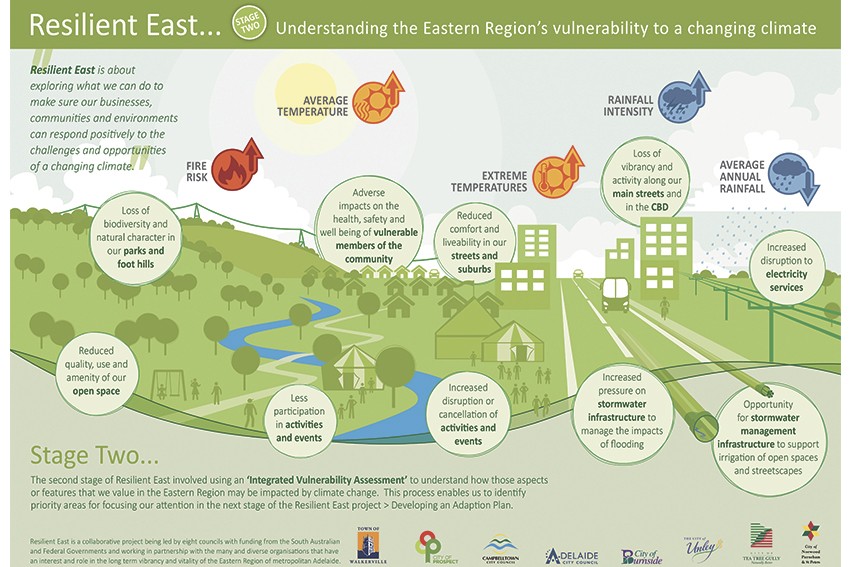Adelaide’s East; resilient in times of change

Climate change is happening now and some impacts are unavoidable.
Leading the way in preparing for climate change, eight eastern metropolitan councils have formed a partnership for the Resilient East project, to understand the challenges of climate change for eastern Adelaide and how to create a prosperous future for the region. All too familiar with popular poetic literature depicting Australia as the land of “droughts and flooding rains” or a “sunburnt country with rolling plains”, South Australians do not live with any misconceptions when it comes to our country’s extreme weather conditions. Yet what we might not fully comprehend is how climate change will see these extremities exacerbate over time, with real implications for our city. Adelaide needs to prepare for the impacts of climate change. But just how prepared are we? Resilient East is an initiative to understand the local impacts of climate change and explore what is needed to safeguard the region’s businesses, communities and environment. When we think of climate change it might conjure up images of rising sea levels and melting polar caps. However, the effects of climate change will inevitably have impacts closer to home. Many may not have considered areas of our everyday existence that will ultimately be impacted by climate change. Implications are wide and varied, with projected changes forecast across the region likely to impact on the economy and productivity; participation in community activities and events; health and wellbeing of vulnerable people in the community; open spaces, parks and reserves; and essential services such as electricity supplies. In the eastern region, climate models forecast substantial changes relating to rainfall intensity, extreme temperatures, water scarcity and fire risk. The number of days over 40 degrees is projected to double by 2050, with heatwave frequency and duration also expected to increase. This, in turn, will contribute to increased bushfire risks with an increase in the number of extreme fire risk days throughout the foothill areas and adjacent peri-urban areas. Water conservation will increasingly become a priority, with average rainfall expected to decrease by seven percent. Flood risk will also increase with the intensity of heavy rainfall increasing by 10 percent by 2050. Working in partnership with a diverse range of organisations, Resilient East’s main objective is to ensure the community, local economy, assets and infrastructure, and the natural environment are resilient, forward–thinking and prepared with a plan to adapt to a future climate. To date the project has identified the main aspects and features of the eastern region that are the most vulnerable to the impacts of climate change thorough a process called an Integrated Vulnerability Assessment. The assessment has provided an important basis from which to focus the development of a Climate Change Adaptation Plan for the east. The Plan will develop a range of regional and local adaption ‘pathways’, to help the eastern region, adapt, thrive and prosper into the future. NOTE: Project partners include the City of Tea Tree Gully, City of Burnside, City of Campbelltown, , City of Unley, City of Norwood Payneham & St Peters, City of Prospect, the Town of Walkerville, Adelaide City Council and URPS and Seed Consulting Services. This article was presented by the Adelaide City Council. resilienteast.org.au